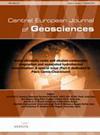2D seismic interpretation of Dun06 projects, Great South Basin, New Zealand
Central European Journal of Geosciences
Pub Date : 2019-04-12
DOI:10.34154/2019-EJGS-0101-02-18/EURAASS
引用次数: 0
Abstract
DUN06 seismic survey was done in the northern part of the Great South Basin of New Zealand with a total of 3110km of high resolution 2D seismic data by Pacific Titan in 2006. This study focuses on 2D seismic interpretation using Petrel Software to interpret the horizons or geological boundaries of different formations based on the extracted well tops from Toroa well which was drilled in the area of interest. The primary objectives of this study are to deduce the structural and stratigraphic information as well as the trapping mechanism of petroleum system if any. Possible indications of the presence of hydrocarbon were also sorted out. There are seven horizons having age ranging from upper Cretaceous to Eocene. Also, approximately 160 faults were interpreted; with two different strike directions; northwest and northeast striking. Several time and depth structure maps were generated. Upon inspection of the facies on the cross section of the seismic images, they areassumed to be deltaic or river channel deposits. The whole structural deformation is classified as syn-rift and post-rift deformation. The latter is divided into first, second and third post rift event. The first two horizons marked the first post-rift event with transgression followed by a set of delta and river channel indicating regression and second post-rift event. The reservoir unit is determined to be PaleoceneDannevirkeTeurian formation and the Early Eocene Paleocene formation acts as the stratigraphic seal and trap for the reservoir unit.新西兰大南盆地Dun06项目二维地震解释
DUN06地震调查是2006年由太平洋泰坦在新西兰大南盆地北部进行的,共获得3110km的高分辨率二维地震数据。本研究的重点是利用Petrel软件进行二维地震解释,根据在感兴趣地区钻探的Toroa井提取的井顶,解释不同地层的层位或地质边界。本研究的主要目的是推断构造和地层信息,以及油气系统的圈闭机制。可能存在碳氢化合物的迹象也被整理出来。有7个层位,年龄从上白垩世到始新世不等。此外,还解释了大约160个断层;有两个不同的走向方向;向西北和东北方向进攻。生成了多个时间和深度构造图。根据地震图像横截面上的相检查,它们被认为是三角洲或河道沉积。整个构造变形可分为同裂谷变形和后裂谷变形。后者分为第一、第二和第三后裂谷事件。前两个层位标志着以海侵为标志的第一次后裂谷事件,随后是一套三角洲和河道,标志着退缩;确定储层单元为古新世-二叠世-条良组,早始新世-古新世组是储层单元的地层密封和圈闭。
本文章由计算机程序翻译,如有差异,请以英文原文为准。
求助全文
约1分钟内获得全文
求助全文
来源期刊

Central European Journal of Geosciences
GEOSCIENCES, MULTIDISCIPLINARY-
自引率
0.00%
发文量
0
审稿时长
>12 weeks
 求助内容:
求助内容: 应助结果提醒方式:
应助结果提醒方式:


